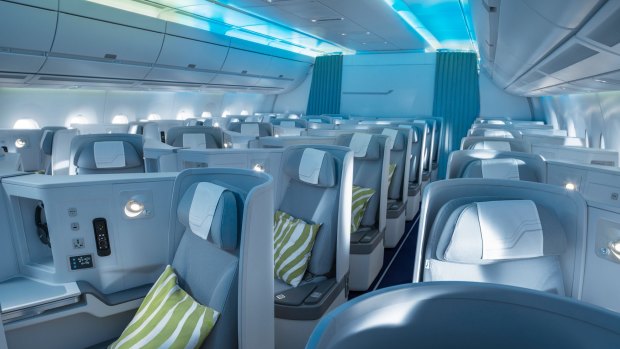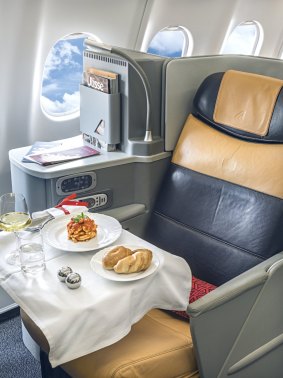This was published 5 years ago
New plane cabin designs: The airlines that are revolutionising the inflight experience
By Natasha Dragun

Finnair A350 business class with Marimekko design collaboration.Credit: Finnair
"Clinical" is a word that springs to mind when considering the aesthetics of flying. The design of airline cabins can be boring and purely functional at best, downright depressing at worst. But a number of airlines are transforming the way we travel the world with cabins that not only fare well in the style stakes, but also give us a taste of our end destination before we arrive.
It makes sense – airports and lounges have long been designed to represent the destinations they serve. Think, the tropical gardens and butterfly enclosure at Singapore's Changi Airport, Qantas' first class lounges decorated with colours of the Australian outback, or Doha's Hamad International Airport, where the undulating roof nods to the waves of the Gulf and walls of glass are decorated with Arabic motifs. It was only a matter of time before the idea took off inside the world's top carriers as well.
In the air, the business class cabin on Finnair's relatively new A350 aircraft is like a slice of Finland. Operating between Singapore and Helsinki, the plane's cabins are illuminated with clouds that drift across a blue sky projected onto the ceiling – later, as you prepare to land, the puffs of white are replaced with an Aurora Borealis-inspired light show. Icelandair's special Hekla Aurora 757 aircraft not only has LED displays of the Northern Lights projected into the main cabin, but also has the colours of the Icelandic winter landscape painted on the external shell of the aircraft.

Alitalia cabin interior.
The entire Finnair A350 cabin has been fitted out by the country's top design firm dSign Vertti Kivi & Co, and the chosen white, blue and silver-grey colour scheme sings Scandinavian style. There is plenty of colour, however, thanks to the use of an eye-popping Marimekko print on duvets, slippers and amenity kits. The food also nods to the Nords with Finnish delicacies on the menu that include Vendace roe mousse, warm smoked Arctic char and wild reindeer. On the beverage list, signature cocktails include the Blue Sky (French champagne and Finnish blueberry liquor), and a gin and tonic using the country's applauded Napue gin, rosemary and fresh cranberries.
See also: Airline review: Finnair economy class
Design elements in business class on Etihad's A380s and 787 fleet give a subtle nod to the carrier's home base of Abu Dhabi. Having seen early architectural plans for the city's new Louvre (opened at the end of 2017), the airline picked up on the dappled "rain of light" effect in the gallery's spectacular dome. It borrowed the idea for the lighting in its Business Studios, First Class and The Residence, creating a comforting glow that mimics the way sun streams through palm fronds in the desert. All aircraft feature sandy hues reminiscent of the vast parched plains of the emirate, as well as geometric patterns and forms characteristic of the region's architecture.
Airlines that have home base in tropical destinations are particularly forward thinking when it comes to incorporating cultural elements into their cabin designs.
Hawaiian Airlines' retrofit of its Boeing 717 fleet took inspiration from the islands the aircraft serves, revealing a "refreshed interior colour palette [that] connects travellers with the islands through earth tones, a deep aqua seat and accents of fuchsia and sky blue", the carrier says.
Fiji Airlines' fleet of A330s features muted, sandy tones and indigenous Masi symbols on both the livery and soft furnishings, including pillows and blankets. The idea, the company says, is to make passengers feel as if they are on vacation as soon as they step on board. Thai Airways' latest business and economy class upgrades include a focus on Thai culture and traditions with teak, silk foil, rattan and bespoke artwork all used to ensure the cabin reflects the country's heritage.
In AirCalin's Hibiscus Class, a palette of blue and grey reflects New Caledonia's dazzling lagoon as seen from the sky. On cabin walls and headrests there's a stylised representation of column pines, an emblematic feature of the archipelago's scenery, while seat covers are inspired by traditional Pacific weaving techniques.
Not to be outdone, Alitalia's brand relaunch saw the airline call on Italian furniture maker Poltrona Frau to stitch the fine leather upholstery on its business class seats, which, unsurprisingly, were designed to resemble those in a luxury sports car. At meal time, passengers dine on fine bone china crafted by Richard Ginori, one of Italy's most distinguished manufacturers of upscale ceramics. Limoncello, amaro and grappa are poured post-meal and luxury linens come courtesy of Frette, and Salvatore Ferragamo provides the amenity kits for business-class flyers. When boarding you'll likely hear Andrea Bocelli's Con Te Partiro. Cheesy? Perhaps, but you certainly won't forget who you're flying with.
CABINS OF THE FUTURE
In March 2018, Qantas began direct flights from Perth to London. That's 14,498 kilometres, or 17 hours in the air. Some analysts say that by 2030, long-haul planes could be in the air for well over 20 hours at a time. Being in a confined space for such an extended period will, inevitably, impact the way aircraft cabins are designed. Although aesthetics will likely change, here are some of the innovations we could look forward to in cabins of the future.
VIRTUAL REALITY (VR)
Many believe that within the next 10 years VR technology will be employed by airlines as a way to change the way we perceive cabins. While watching a film on the in-flight entertainment system, passengers in economy class may choose to be transported to a movie theatre, or picture themselves walking through a rainforest, or lying on a tropical beach. Which raises the question, why leave home at all? Airbus recently launched "the future by Airbus" concept to show just what plane travel might be like by 2050. It incorporates a number of VR components, including on-board golf simulators and conferencing facilities, as well as holographic touch screens for entertainment systems and an entire seating area surrounded by a transparent "membrane", allowing passengers to gaze at the sky.
DYNAMIC LAYOUTS
Industry insiders predict that when we're in the air for longer, there will be a need to have cabins with less rigid layouts. Which means potentially having child-free and women-only zones, as well as more areas for standing, stretching and mingling – congregating in the bulkhead by the toilets won't cut it anymore. Some say we may see vertically staggered seating to make the most of the full height of the cabin.
PERSONALISATION
Just because the person sitting next to you wants to sleep doesn't mean that you should feel obliged to do the same thing. It's thought that within the next decade cabins will be equipped with technology to allow passengers to control their immediate environment and personalise the lighting levels, scents and temperature of specific seats. When you're hungry, order a meal through your tablet and collect it from the galley when it's ready.
INTELLIGENT SYSTEMS
Today's passengers may have trouble finding their seat despite it being printed on their boarding pass. But imagine if your seat found you? Technology-assisted seats of the future may allow for seats to "recognise" not only who is sitting in them, but also store data on how that passenger likes to sit and what their preferences are when it comes to in-flight entertainment, based on what they've watched in the air previously and also what they were watching at home before jumping on the plane.
See also: 'Torture chamber': New design for standing seats on planes
See also: Folding seats, beds in the cargo hold: The top new plane cabin designs for 2019
Sign up for the Traveller newsletter
The latest travel news, tips and inspiration delivered to your inbox. Sign up now.